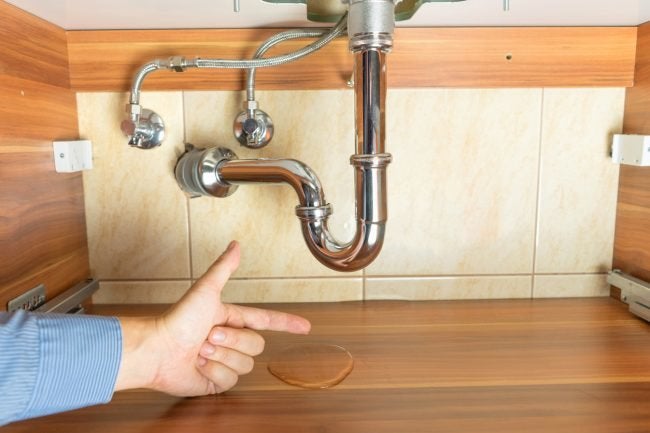Spot Sneaky Water Line Leaks: Six Clever Detection Tricks
Spot Sneaky Water Line Leaks: Six Clever Detection Tricks
Blog Article
We've come across this post on Detecting hidden plumbing leaks down the page on the net and accepted it made sense to talk about it with you on this site.

The minute you find a leakage, calling your plumber for repairs is the very best solution. Nevertheless, some little water leaks may not be visible. Right here are some hacks that help if you can not find it with your nude eyes.
Early discovery of leaking water lines can alleviate a potential disaster. Besides saving you money, it will certainly decrease the aggravation and irritation.
Examine Water Consumption
If you find unexpected modifications, in spite of your consumption being the exact same, it implies that you have leaks in your plumbing system. A sudden spike in your bill indicates a fast-moving leak.
A consistent boost every month, even with the same habits, reveals you have a slow-moving leak that's additionally gradually intensifying. Call a plumber to thoroughly check your home, especially if you really feel a cozy area on your floor with piping beneath.
Assess the circumstance and evaluate
Home owners must make it a practice to examine under the sink counters as well as even inside closets for any type of bad odor or mold development. These two red flags suggest a leak so timely attention is needed. Doing routine examinations, also bi-annually, can save you from a significant problem.
Check Out the Water Meter
Every home has a water meter. Inspecting it is a surefire manner in which helps you uncover leaks. For beginners, shut off all the water resources. Guarantee no person will flush, use the faucet, shower, run the cleaning maker or dish washer. From there, most likely to the meter and also watch if it will transform. Because nobody is utilizing it, there ought to be no activities. That suggests a fast-moving leak if it relocates. Furthermore, if you discover no changes, wait a hr or two and also check back once again. This implies you might have a slow leak that can also be underground.
Asses Exterior Lines
Don't fail to remember to inspect your outside water lines also. Examination faucets by attaching a garden pipe. Needs to water seep out of the connection, you have a loosened rubber gasket. Change this and guarantee all links are limited. It will assist get it skillfully checked out and maintained annually if you've got a lawn sprinkler system. One tiny leakage can waste tons of water and spike your water bill.
Do a Food Coloring Examination
When it comes to water intake, 30% comes from commodes. If the shade somehow infiltrates your dish during that time without flushing, there's a leak between the storage tank as well as bowl.
Examine for discolorations and also deteriorating as many appliances and also pipes have a life expectations. If you think dripping water lines in your plumbing system, don't wait for it to rise.
The moment you discover a leakage, calling your plumber for repair services is the best option. Some little water leaks might not be noticeable. Inspecting it is a surefire method that helps you find leakages. One small leak can throw away heaps of water as well as surge your water costs.
If you think dripping water lines in your plumbing system, don't wait for it to intensify.
How to Know If Your Home Has a Hidden Leak
Water Meter Reveals Inexplicable Water Usage
If you’d like to test whether or not there’s a leak somewhere in your home, you can do this using your water meter. Here is how to conduct the test:
Don’t use any water in your home for at least 30 minutes; this also means not turning on faucets or water-using appliances.
Go outside, and check your water meter for activity.
If your water meter shows that there was activity, even though no one was using any water, this proves that there is a leak in your home.
Visible Mold or Mildew Growth
Leaks behind walls create moist, dark environments that allow mold and mildew to grow and thrive. Eventually, you might see mold growth forming on the wall closest to a hidden leak.
If mold is growing in an area that receives a high amount of moisture, such as a bathroom, it may simply be an indication that better ventilation is needed. However, if you see mold growth on a wall or the ceiling in an area where you would not expect, you probably have a hidden leak.
Musty, Mildew Odor
Sometimes you might not be able to see the mold or mildew that is growing as a result of a leak. However, the smell can give the problem away just as easily. If you catch a whiff of something musty, there’s a good chance that old water is collecting somewhere in your home that you can’t see.
Stained/Warped Walls, Ceilings, or Floors
When your home soaks up water, a variety of red flags can become visible, including ceiling stains, bubbling drywall, warped walls, and sagging floors. While these issues can be caused by excess humidity, they can also be signs that a pipe or plumbing connection has started leaking behind your walls.
Inexplicably High Water Bill
After a while, you get a general sense for what your water bill should be. If you own a pool or sprinkler system, your bill will tend to be higher during summer. However, if you receive a water bill that seems especially high, and you can’t figure out what caused it, then you may have a hidden leak somewhere that’s increasing your bill.
https://www.plumbingjoint.com/blog/2019/july/how-to-know-if-your-home-has-a-hidden-leak/

I came across that content on Top leak detection hacks when doing a lookup on the search engines. If you enjoyed our blog posting please remember to pass it around. Thanks a bunch for your time. Visit us again soon.
Burst pipes? Get immediate help. Report this page